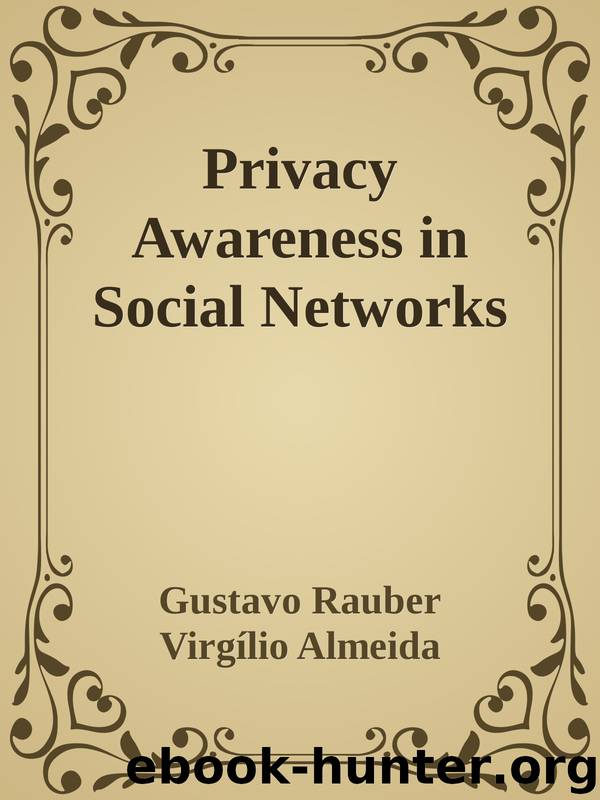Privacy Awareness in Social Networks by Gustavo Rauber & Virgílio Almeida

Author:Gustavo Rauber & Virgílio Almeida [Rauber, Gustavo]
Language: eng
Format: epub
Published: 2017-06-15T07:00:00+00:00
5.5. H5: Friends List Exposure
33
of his friends list, but not every application needs it or should have access to it. It is
possible to hide the friends list from particular friends on the user profile page but not
from applications, which are made most of the time by complete strangers and most
of whom are rarely full of good intentions.
These results refute Hypothesis 5.
Figure 5.5. Example of a simple permission request dialog on Facebook. The
friends list is treated as a basic information such as the name or the gender of the
user and does not require a specific permission.
34
Chapter 5. Results
5.6
H6: Date of Birth Exposure
Using the P F data set, no huge contrast was found between Brazil and India with
respect to date of birth protection. Nonetheless, the exposure levels are disturbingly
high for such a personal information (refer to Figure 5.6). In Brazil, about 64.4% of the participants and their friends expose their full date of birth to their network, while
in India the equivalent statistic is a bit lower, at 62.3%.
An important contrast was found between genders concerning the date of birth
exposure. Although still high, women seem to be more concerned than men regarding
its exposure, wheresoever. For instance, in Brazil 60.7% of the women expose their full
date of birth while the same statistic reaches 71.6% of the men. The full results are
presented in Table 5.6.
70
Brazil
60
India
All
50
40
centage 30
Per
20
10
0
Full Birthday
MonthDay
Not Disclosed
Figure 5.6. Date of birth exposure distribution from the data set P F . The
majority of users expose their full birthday.
The age distribution of users could be derived from those who disclose their date
of birth (refer to Figure 5.7). It is observed that participants and their networks of friends are concentrated in young age strips (< 36 years). One might think that there
is an over representation from these age strips but, according to Facebook Ads [2012],
they represent 76% and 90% of users in Brazil and India, respectively.
These results refute Hypothesis 6.
5.6. H6: Date of Birth Exposure
35
100
Over 55
46-55
80
36-45
26-35
18-25
centage
Under 18
60
er
40
ccumulated P
20
A
0
Brazil
India Others
All
Figure 5.7. Age breakdown from those in the P F data set who revealed their
date of birth. The majority of users belong to 18 – 35 years age group.
Table 5.6. Full date of birth exposure reach across different genders in the P F
data set. A high percentage of users share their birthdate with their network,
specially men. Figures with 95% confidence level.
Female
Male
Avg(%) ± Std. Error
Avg(%) ± Std. Error
Brazil
60.70 ± 0.02
71.61 ± 0.01
India
58.11 ± 0.02
64.60 ± 0.01
Others
52.54 ± 0.02
54.81 ± 0.01
All
62.07 ± 0.01
68.76 ± 0.01
36
Chapter 5. Results
5.7
Further Analyses
5.7.1
Egocentric Networks
Even though most people have hundreds of friends on OSNs like Facebook, it is hard
to maintain a stable social relationship with all of them.
In fact, this number of
average stable social relationships one can maintain (known as Dunbar’s number) has
been calculated and lies between 100 and 230, although 150 is a commonly accepted
value [Hernando, A. et al., 2010]. Features like wall posts, personal messages and comments on shared items allow users to interact virtually to a great number of friends
asynchronously. One feature, though, reflects a kind of interaction that is only possible
in real life: photo albums, since you can only take pictures with people you have met
personally.
Download
This site does not store any files on its server. We only index and link to content provided by other sites. Please contact the content providers to delete copyright contents if any and email us, we'll remove relevant links or contents immediately.
Algorithms of the Intelligent Web by Haralambos Marmanis;Dmitry Babenko(8522)
Test-Driven Development with Java by Alan Mellor(7427)
Data Augmentation with Python by Duc Haba(7317)
Principles of Data Fabric by Sonia Mezzetta(7065)
Learn Blender Simulations the Right Way by Stephen Pearson(7006)
Microservices with Spring Boot 3 and Spring Cloud by Magnus Larsson(6825)
RPA Solution Architect's Handbook by Sachin Sahgal(6234)
Hadoop in Practice by Alex Holmes(6032)
The Infinite Retina by Robert Scoble Irena Cronin(5934)
Jquery UI in Action : Master the concepts Of Jquery UI: A Step By Step Approach by ANMOL GOYAL(5873)
Big Data Analysis with Python by Ivan Marin(5732)
Life 3.0: Being Human in the Age of Artificial Intelligence by Tegmark Max(5404)
Pretrain Vision and Large Language Models in Python by Emily Webber(4693)
Infrastructure as Code for Beginners by Russ McKendrick(4471)
WordPress Plugin Development Cookbook by Yannick Lefebvre(4204)
Functional Programming in JavaScript by Mantyla Dan(4124)
The Age of Surveillance Capitalism by Shoshana Zuboff(4117)
Embracing Microservices Design by Ovais Mehboob Ahmed Khan Nabil Siddiqui and Timothy Oleson(3995)
Applied Machine Learning for Healthcare and Life Sciences Using AWS by Ujjwal Ratan(3971)
